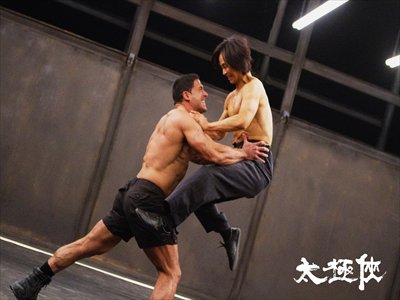Reeves goes retro

Tiger Chen (right) stars in Man of Tai Chi Photo: CFP
It's been a while for international audiences to see a pure kung fu movie with little use of weapons and glamorous special effects, but action star Keanu Reeves has just contributed one to the global cinema in his directorial debut.
It might not have many sophisticated lines or a complex plot, but the Chinese-US co-production Man of Tai Chi packs a wallop where it intended - in a series of one-on-one martial arts bouts. The result: Audiences see a very conventional, even old-school action movie.
Thorough preparation
Keanu Reeves is well known by the Chinese audience for his roles in The Matrix trilogy and Speed. After he switched his focus to independent productions, his face was seen less often on the big screens or magazine covers around China. However, in recent years, he has been actively involved in many events held in China. Photos of him and gossip about his gaining weight (true or not) have been popular on Sina Weibo.
Last week, he handed in his homework - a film featuring his Matrix kung fu teacher Tiger Chen. This result of the time Reeves spent in China shows his understanding of Chinese kung fu as well as the culture.
Reeves also co-stars in the film as its main villain, maintaining a cold countenance throughout and wearing all black, reminiscent of his look in The Matrix.
The film tells the story of a martial artist, played by Tiger Chen (also called Tiger in the movie), who is set up to fight in underground tournaments.
In a similar storyline that could remind the audience of Wu Jing's Fatal Contact or Xiong Xinxin's Coweb, Tiger faces various temptations and challenges.
One of the film's highlights is that it includes textbook examples of different styles of kung fu. This feature may remind audience members of other films like Legend of the Fist: The Return of Chen Zhen directed by Lau Wai-keung and Bruce Lee's The Way of the Dragon.
Kung fu philosophy
"Slow down," is an important line in the film that Tiger's teacher, the tai chi master who lives in a temple, continues to tell Tiger as they practice kung fu.
As the protagonist, Tiger must face the same doubts that almost all martial artists in such action films have had to face: He must decide how to use and control his power and what he should fight for.
To treat the world with supramundane visions or an ordinary mind is an ultimate question for anyone who learns Chinese kung fu. And they are questions asked by both the bright side and the dark side in this film.
The convention is that martial artists are not allowed to fight in real life because kung fu is never about hurting others and should be used as a path to physical improvement.
However, when society needs someone powerful or there is a situation in which the power of kung fu can benefit more people, each martial artist faces a choice. The contradiction creates drama and leads to deeper questions, which is why in many films kung fu masters are often also philosophers.
Reeves explained at a press conference in Beijing last week that he and Chen decided to spotlight the martial art tai chi because it can be used to fight but also has its "inside" aspect. With the movie, Reeves intended to explain tai chi's ideology, and from the very first scene when Tiger goes to see his teacher, the part about "mediation and controlling" is emphasized.
Unfortunately, the end of the film feels a bit rushed. The antagonist Donaka's role as the source of the darkness and evil breaks with his consistent mystery and cruelty; while Chen's sudden enlightenment at the end is hardly persuasive.
In comparison with the old Hong Kong kung fu movies when the hero's power is boosted as he witnesses his loved ones getting hurt or examples like The Dark Knight Rises where Batman is beaten nearly to death and has to spend several months recuperating and considering his next move, Tiger's change is too simplistic.
One of the rules of kung fu movies is that what makes a martial artist suddenly understand things he never understood in the past is probably not from more fighting, since that is what he has been doing all along.
High production value
Reeves invited a quality production team including photography director Elliot Davis (The Iron Lady, Twilight), script writer Michael Cooney, editor Derek Hui (Bodyguards and Assassins), art director Yohei Taneda (Kill Bill) and action director Yuen Woo-ping (Crouching Tiger, Hidden Dragon).
Tiger's life and the light and dark side are separated by settings in Beijing and Hong Kong. The scenes of the cities are clearly presented. And Reeves made an effort to understand Chinese culture, which is reflected in the way he presents Tiger's family.
All the supporting roles are also clearly differentiated. For Chinese audiences who are familiar with Hong Kong films, the supporting actors including Sam Lee were common faces in cinemas. And one of the fighting roles, although he does not wear a monk's robe, is still recognizable as being from Shaolin Temple, which fits into the expectations of kung fu fans.
The 14 brutal one-on-one fights cover various styles of martial and kickboxing. The editing is also solid, not too fast to cheat the audience's eye like many action films do.
Nevertheless, another missed opportunity that kept Reeves from stepping beyond simply making a conventional action movie to possibly creating a real box-office success is the way he handled the part where Tiger finds out that his life was under surveillance and being made into a show for a members-only club. It seems the difference between an average film and a great one is often not about ideas but about how those ideas are illustrated.